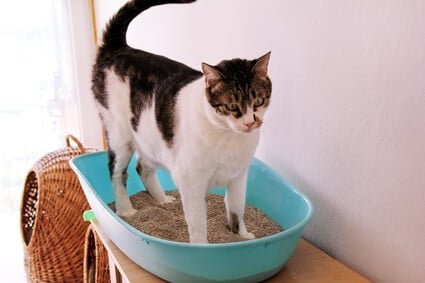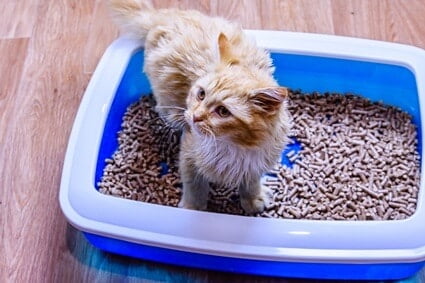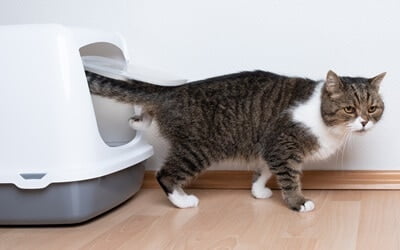Cats can develop behaviors that owners find difficult to understand, such as scratching the floor after pooping. This behavior usually occurs when a litter box fails to mask the scent of its excrement.
Cats scratch the floor after pooping to hide the smell of their waste, but are thwarted from doing so by uncleanliness and space restrictions. So, ensure its litter box is cleaned to remove the smell of waste, and that the tray is 1.5 times its length with higher walls to prevent content spillage.
These are the most common explanations, but there are cats that scratch the floor after going to the toilet for other reasons. Some cats paw the floors to clean their nails or do so out of habit.
Why Do Cats Scratch To Bury Waste?
Cats are hardwired to hide their poop, or at least its smell. Consider a house cat’s untamed ancestors in the wild. Wild cats are predators and prey, so they must ensure that they keep themselves hidden.
This problem with a cat’s waste as cat urine has a potent smell. In the wild, cats will do anything to hide their scent as it’s a matter of life and death.
To mask their presence, cats hide their poop, burying them in the soil. If your cat goes to the toilet outside, you’ll have almost certainly have observed this behavior.
While your home is completely different, your cat still has the same instincts as its wild ancestors.
Why Does My Cat Scratch The Floor?
Indoors, the soil is substituted with cat litter. Ideally, your cat will bury its poop in the litter by scratching inside the box, burying it underneath. This ensures that the smell is hidden away.
However, there are reasons why a cat will paw at the floor nearby:
- Litter box is too small: The cat’s outgrown its box, or it was never the right size.
- Tray sides too low: Poop can spill over the sides, along with the smell.
- Unclean: The litter tray is unclean and has a strong odor.
Litter Box Recommendations
When getting a litter box, consider your cat’s preferences. So, you may need to swap out one litter tray for another until you make the right choice.
Box Size
Some cats are much bigger than others, so measure your cat from nose to tail.
Ensure that you get a litter box at least 1.5 times your cat’s length. This will allow enough room for your cat to bury its waste and turn around easily.
However, some cats prefer tight spaces because they feel more secure in smaller spaces that provide privacy.
Higher Tray Sides
Get a litter box with walls that are 5+ inches tall to avoid spillage. If your cat tends to kick or spray its litter everywhere, you may wish to opt for 8 to 12-inch walls.
However, remember that your cat needs to get in and out of its litter box easily, especially if it has stiff limbs. If so, select a litter box with lower walls as your cat’s ability to use the tray is most important.
Hooded or Not
According to the Journal of Feline Medicine and Surgery, most cats don’t have a preference for a hood. What matters is that the box is kept clean and properly maintained. However, a hood offers the cat more privacy and security.
Type of Cat Litter
The type of litter you use can be a huge factor in ensuring that your cat’s poop doesn’t smell.
This is what scientific research has found:
- Cats showed a preference for litter made of clay substrate.
- There wasn’t much difference between scented and unscented litter.
- According to the Journal of Feline Medicine and Surgery, cats like odor eliminators in their litter boxes.

Swapping Litter Boxes
To swap the boxes, place the new litter box next to the old one.
This is important for these reasons:
- The cat already knows its designated spot and likely prefers that location.
- You can determine if the litter box is the problem. Ideally, your cat will use the new litter box.
How To Clean a Dirty Litter Box
Above all else, litter box cleanliness is the biggest factor in stopping your cat from scratching after pooping.
To ensure that you’re cleaning your cat’s box properly, follow these steps:
Fill The Litter Box
Fill the litter box with 2-3 inches of litter.
Some cats like to bury deep. If your cat is one of them, opt for a depth of 3 inches as a minimum. You may need to experiment to find the depth that your cat prefers.
Scoop Up The Poop
To keep your cat’s litter box clean, scoop up cat poop after usage.
Clumping litter will stick to the poop due to a substance called bentonite. Throw the waste in a plastic bag and tie it securely before discarding it.
Top up your cat’s litter after every scoop to ensure it’s right.
Replace The Litter
Litter should be replaced about twice a week, depending on the litter you use.
If you have clumping litter, you can replace the litter less often, perhaps every 2 to 3 weeks. Non-clumping litter will need more changes because urine is more likely to settle at the bottom of the box.
Urine is commonly why litter boxes smell, as it tends to linger more than cat poop.
Scrub The Box
Clean the box every time you replace the litter. Avoid harsh cleaning agents, especially those with strong smells. This includes citrus (orange and lemon) fragrances.

Cat Won’t Stop Scratching The Floor
There may be other reasons for the issue:
Grooming
Your cat may be cleaning its claws after pooping.
Most cats are content with chewing at their paws and claws to remove dirt/debris. However, cats also file down their nails by scratching the floor.
Ideally, this is done via a scratching post, but some cats want to clean their nails immediately after going to the toilet.
Habit
Some cats scratch the floor out of habit. For example, the cat’s mother may have taught it to scratch after pooping. Kittens will follow their mother’s habits, regardless of whether they’re functional.
Cats scratching after pooping isn’t harmful, but it is a sign that something may need to be done to correct the behavior. If you’ve done your best to ensure that your cat’s litter box is clean and spacious and your cat continues to scratch, it may just be out of habit. To break the habit, further training will be needed.

